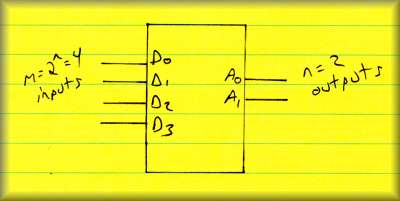

Block diagram:

| m (<= 2n) inputs | |
| n outputs | |
| Design assumes that only one input is on (logic 1) at any time | |
| If more than one input is 1, then behavior is undefined | |
| If no inputs are 1 (all 0's), then behavior is undefined |
Consumes minterms, rather than producing them...
so, generally less useful for our logic design purposes.
Get rid of the ambiguities of the vanilla encoder
| If two or more inputs are 1, the higher-order bits take precedence | |
| Add a V (for valid) output, that is set to 0 if all inputs are 0 |